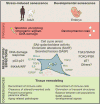A new development in senescence
- PMID: 24267881
- PMCID: PMC4702512
- DOI: 10.1016/j.cell.2013.10.050
A new development in senescence
Abstract
Cellular senescence is implicated in several pathological responses in the adult, with important repercussions in tumor suppression, wound healing, and aging. Two studies by Muñoz-Espín et al. and Storer et al. now reveal that senescence contributes to embryonic development, suggesting a primordial role in normal physiology.
Copyright © 2013 Elsevier Inc. All rights reserved.
Figures

Comment on
-
Senescence is a developmental mechanism that contributes to embryonic growth and patterning.Cell. 2013 Nov 21;155(5):1119-30. doi: 10.1016/j.cell.2013.10.041. Epub 2013 Nov 14. Cell. 2013. PMID: 24238961
-
Programmed cell senescence during mammalian embryonic development.Cell. 2013 Nov 21;155(5):1104-18. doi: 10.1016/j.cell.2013.10.019. Epub 2013 Nov 14. Cell. 2013. PMID: 24238962
References
-
- Campisi J. Nat Rev Cancer. 2003;3:339–349. - PubMed
Publication types
MeSH terms
Grants and funding
LinkOut - more resources
Full Text Sources
Other Literature Sources

